Forecasting the Scientific Production Volumes of G7 and BRICS Countries in a Comparative Analysis
Abstract
1. Introduction
- I.
- What are the characteristics of scientific production growth in the last thirty years within G7 and BRICS countries?
- II.
- What are the growth forecasts for these countries by 2030?
2. Materials and Methods
2.1. Data Description
2.2. Methodology
- : scientific production at time t; : autoregressive polynomial of degree p; : moving average polynomial of degree q; : differencing operator of order d; = backshift operator, such that = ; = error terms distributed as withe noise ~N (0; σ2).
3. Main Literature Review
4. Results and Discussion
4.1. Countries Description
4.2. Trends of Scientific Production
4.3. Arima Models Fitting Results for Scientific Production (1996–2023)
4.4. Arima Models Post-Estimation
4.5. Arima Models for Forecasting (2024–2030)
5. Implications and Conclusions
5.1. Key Findings
5.2. Implications and Policy Recommendations
5.3. Study Limitations
5.4. Future Research and Contributions to the Literature
Funding
Data Availability Statement
Conflicts of Interest
References
- Aithal, P. S., & Aithal, S. (2020). Implementation strategies of higher education part of national education policy 2020 of India towards achieving its objectives. International Journal of Management, Technology, and Social Sciences (IJMTS), 5(2), 283–325. [Google Scholar] [CrossRef]
- Arimoto, T. (2024). The transformation of science, technology and innovation (STI) policy in Japan. Asia Pacific Business Review, 30(3), 485–498. [Google Scholar] [CrossRef]
- Atkinson, R., & Zhang, L. (2024). Assessing Canadian innovation, productivity, and competitiveness. ITIF. [Google Scholar]
- Bornmann, L., & Mutz, R. (2015). Growth rates of modern science: A bibliometric analysis based on the number of publications and cited references. Journal of the Association for Information Science and Technology, 66(11), 2215–2222. [Google Scholar] [CrossRef]
- Bouabid, H., Paul-Hus, A., & Larivière, V. (2016). Scientific collaboration and high-technology exchanges among BRICS and G-7 countries. Scientometrics, 106, 873–899. [Google Scholar] [CrossRef][Green Version]
- Bratti, M., Tindaro, C., Lippo, E., Nappi, C. A., & Turri, M. (2021). The effect of research evaluation exercises on research output: Fifteen years of evidence from Italy. Politica Economica, 37(1), 13–42. [Google Scholar] [CrossRef]
- Brint, S., & Carr, C. E. (2017). The scientific research output of US research universities, 1980–2010: Continuing dispersion, increasing concentration, or stable inequality? Minerva, 55, 435–457. [Google Scholar] [CrossRef]
- Carpentier, V., & Courtois, A. (2024). Higher education and the public good in France. Higher Education, 89, 223–238. [Google Scholar] [CrossRef]
- Chen, D. H., & Dahlman, C. J. (2005). The knowledge economy, the KAM methodology and World Bank operations. (World Bank Institute Working Paper, 37256). World Bank. [Google Scholar]
- Esh, M. (2024). Predicting future citations from AI publication trends: A comparative analysis of forecasting models. The Serials Librarian, 85, 155–168. [Google Scholar] [CrossRef]
- European Commission. (2024). Science, research and innovation performance of the EU 2024 report. Available online: https://research-and-innovation.ec.europa.eu/knowledge-publications-tools-and-data/publications/all-publications/science-research-and-innovation-performance-eu-2024-report_en (accessed on 2 February 2025).
- Furman, J. L., Porter, M. E., & Stern, S. (2002). The determinants of national innovative capacity. Research Policy, 31(6), 899–933. [Google Scholar] [CrossRef]
- Fuyuno, I. (2012). Numbers of young scientists declining in Japan. Nature News. [Google Scholar] [CrossRef]
- Gao, J., Yin, Y., Myers, K. R., Lakhani, K. R., & Wang, D. (2021). Potentially long-lasting effects of the pandemic on scientists. Nature Communications, 12(1), 6188. [Google Scholar] [CrossRef]
- Hatemi-J, A., Ajmi, A. N., El Montasser, G., Inglesi-Lotz, R., & Gupta, R. (2016). Research output and economic growth in G7 countries: New evidence from asymmetric panel causality testing. Applied Economics, 48(24), 2301–2308. [Google Scholar] [CrossRef]
- Highman, L., Marginson, S., & Papatsiba, V. (2023). Higher education and research: Multiple negative effects and no new opportunities after Brexit. Contemporary Social Science, 18(2), 216–234. [Google Scholar] [CrossRef]
- Horta, H., & Veloso, F. M. (2007). Opening the box: Comparing EU and US scientific output by scientific field. Technological Forecasting and Social Change, 74(8), 1334–1356. [Google Scholar] [CrossRef]
- Hyndman, R. J., & Khandakar, Y. (2008). Automatic time series forecasting: The forecast package for R. Journal of Statistical Software, 27, 1–22. [Google Scholar] [CrossRef]
- Hyndman, R. J., Athanasopoulos, G., Bergmeir, C., Caceres, G., Chhay, L., O’Hara-Wild, M., Petropoulos, F., Razbash, S., Wang, E., Yasmeen, F., Garza, F., Girolimetto, D., Ihaka, R., R Core Team, Reid, D., Shaub, D., Tang, Y., Wang, X., & Zhou, Z. (2020). Package ‘forecast’. Available online: https://cran.r-project.org/web/packages/forecast/forecast.pdf (accessed on 4 February 2025).
- Ioannidis, J. P., Boyack, K. W., & Klavans, R. (2014). Estimates of the continuously publishing core in the scientific workforce. PLoS ONE, 9(7), e101698. [Google Scholar] [CrossRef] [PubMed]
- Khamdamov, S. J., Makhmudov, S., Talapova, N. B., Mamadiyarov, Z., Rejapova, N. B., & Valieva, S. K. (2008). Forecasting the growth of scientific research funding in Uzbekistan’s higher education system: An ARIMA model approach. Current Dynamics in Business and Economics: Theoretical Approaches and Empirical Discoveries, 257. [Google Scholar]
- King, D. A. (2004). The scientific impact of nations. Nature, 430(6997), 311–316. [Google Scholar] [CrossRef]
- Labate, M. G., Waterson, M., Alachkar, B., Hendre, A., Lewis, P., Bartolini, M., & Dewdney, P. (2022). Highlights of the square kilometre array low frequency (SKA-LOW) telescope. Journal of Astronomical Telescopes, Instruments, and Systems, 8(1), 011024. [Google Scholar] [CrossRef]
- Makkonen, T., & Mitze, T. (2023). Geopolitical conflicts, sanctions and international knowledge flows: EU–Russia collaboration during the Ukraine crisis. The World Economy, 46(10), 2926–2949. [Google Scholar] [CrossRef]
- Mansfield, E. (1991). Academic research and industrial innovation. Research Policy, 20(1), 1–12. [Google Scholar] [CrossRef]
- Marginson, S. (2011). Higher education in East Asia and Singapore: Rise of the Confucian model. Higher Education, 61, 587–611. [Google Scholar] [CrossRef]
- Marginson, S. (2022). Global science and national comparisons: Beyond bibliometrics and scientometrics. Comparative Education, 58(2), 125–146. [Google Scholar] [CrossRef]
- Mayosi, B. M., Lawn, J. E., Van Niekerk, A., Bradshaw, D., Karim, S. S. A., & Coovadia, H. M. (2012). Health in South Africa: Changes and challenges since 2009. The Lancet, 380(9858), 2029–2043. [Google Scholar] [CrossRef]
- McManus, C., Baeta Neves, A. A., Audy, J. N., & Prata, A. T. (2024). Public research institutes in Brazil: Evidence of research and innovation impact. Innovation: The European Journal of Social Science Research, 1–23. [Google Scholar] [CrossRef]
- Monroy, S. E., & Diaz, H. (2018). Time series-based bibliometric analysis of the dynamics of scientific production. Scientometrics, 115, 1139–1159. [Google Scholar] [CrossRef]
- Morgan, A. C., LaBerge, N., Larremore, D. B., Galesic, M., Brand, J. E., & Clauset, A. (2022). Socioeconomic roots of academic faculty. Nature Human Behaviour, 6(12), 1625–1633. [Google Scholar] [CrossRef]
- Neureiter, N. P., & Cheetham, M. (2013). The Indo-US science and technology forum as a model for bilateral cooperation. Science & Diplomacy, 2(4). Available online: https://www.sciencediplomacy.org/editorial/2013/indo-us-science-and-technology-forum-model-for-bilateral-cooperation (accessed on 5 December 2024).
- Nwadiuko, J., Switzer, G. E., Stern, J., Day, C., & Paina, L. (2021). South African physician emigration and return migration, 1991–2017: A trend analysis. Health Policy and Planning, 36(5), 630–638. [Google Scholar] [CrossRef]
- Pinto, T., & Teixeira, A. A. (2020). The impact of research output on economic growth by fields of science: A dynamic panel data analysis, 1980–2016. Scientometrics, 123(2), 945–978. [Google Scholar] [CrossRef]
- Pinz, A., Roudyani, N., & Thaler, J. (2021). Public-private partnerships as instruments to achieve sustainability-related objectives: The state of the art and a research agenda. Sustainable Public Management, 3–24. [Google Scholar] [CrossRef]
- Pranckutė, R. (2021). Web of Science (WoS) and Scopus: The titans of bibliographic information in today’s academic world. Publications, 9(1), 12. [Google Scholar] [CrossRef]
- Ramoutar-Prieschl, R., & Hachigonta, S. (2020). Management of research infrastructures: A South African funding perspective (p. 103). Springer Nature. [Google Scholar] [CrossRef]
- Rana, S., Verma, S., Haque, M. M., & Ahmed, G. (2022). Conceptualizing international positioning strategies for Indian higher education institutions. Review of International Business and Strategy, 32(4), 503–519. [Google Scholar] [CrossRef]
- Sattiraju, V. K., & Janodia, M. D. (2024). Analysis of science, technology and innovation (STI) policies of India from 1958 to 2020. Journal of Science and Technology Policy Management, 15(6), 1691–1708. [Google Scholar] [CrossRef]
- Shashnov, S., & Kotsemir, M. (2018). Research landscape of the BRICS countries: Current trends in research output, thematic structures of publications, and the relative influence of partners. Scientometrics, 117(2), 1115–1155. [Google Scholar] [CrossRef]
- Shumway, R. H., Stoffer, D. S., & Stoffer, D. S. (2000). Time series analysis and its applications (Vol. 3, p. 4). Springer. [Google Scholar] [CrossRef]
- Silva, D. R. D. M., Lucas, L. O., & Vonortas, N. S. (2021). Internal barriers to innovation and university-industry cooperation among technology-based SMEs in Brazil. In The Influence of Internal Barriers on Open Innovation (pp. 31–59). Routledge. [Google Scholar] [CrossRef]
- Singh, M. K. (2022). Scholarly efforts of Indian Space Research Organisation during 2002–2021: Mapping and Visualization. Library Waves, 8(1), 1–18. [Google Scholar]
- Soares, F. L. D. T. (2024). The role of the private sector in the promotion of the sustainable development agenda: A study case of Japan and Germany [Ph.D. thesis, Universidade de Brasília]. Available online: http://repositorio2.unb.br/jspui/handle/10482/48393 (accessed on 5 December 2024).
- Song, Y., & Cao, J. (2022). An ARIMA-based study of bibliometric index prediction. Aslib Journal of Information Management, 74(1), 94–109. [Google Scholar] [CrossRef]
- Tilak, J. B., & Kumar, A. G. (2022). Policy changes in global higher education: What lessons do we learn from the COVID-19 pandemic? Higher Education Policy, 35(3), 610. [Google Scholar] [CrossRef] [PubMed]
- Tollefson, J., & Van Noorden, R. (2024). The US is the world’s science superpower—But for how long? Nature, 634(8035), 770–774. [Google Scholar] [CrossRef]
- UNESCO Institute for Statistics. (2024). UIS.STAT database. Available online: http://data.uis.unesco.org (accessed on 4 February 2025).
- Wagner, M., Schaltegger, S., Hansen, E. G., & Fichter, K. (2021). University-linked programmes for sustainable entrepreneurship and regional development: How and with what impact? Small Business Economics, 56, 1141–1158. [Google Scholar] [CrossRef]
- Woolston, C. (2023). What China’s leading position in natural sciences means for global research. Nature, 620(7973), 2–5. [Google Scholar] [CrossRef] [PubMed]
- Yue, X., Feng, Y., & Ye, Y. (2021). A model of sustainable leadership for leaders in double first-class universities in China. International Journal of Higher Education, 10(3), 187–201. [Google Scholar] [CrossRef]
- Zhi, Q., & Pearson, M. M. (2017). China’s hybrid adaptive bureaucracy: The case of the 863 program for science and technology. Governance, 30(3), 407–424. [Google Scholar] [CrossRef]
- Zhu, J., & Liu, W. (2020). Comparing like with like: China ranks first in SCI-indexed research articles since 2018. Scientometrics, 124(2), 1691–1700. [Google Scholar] [CrossRef]
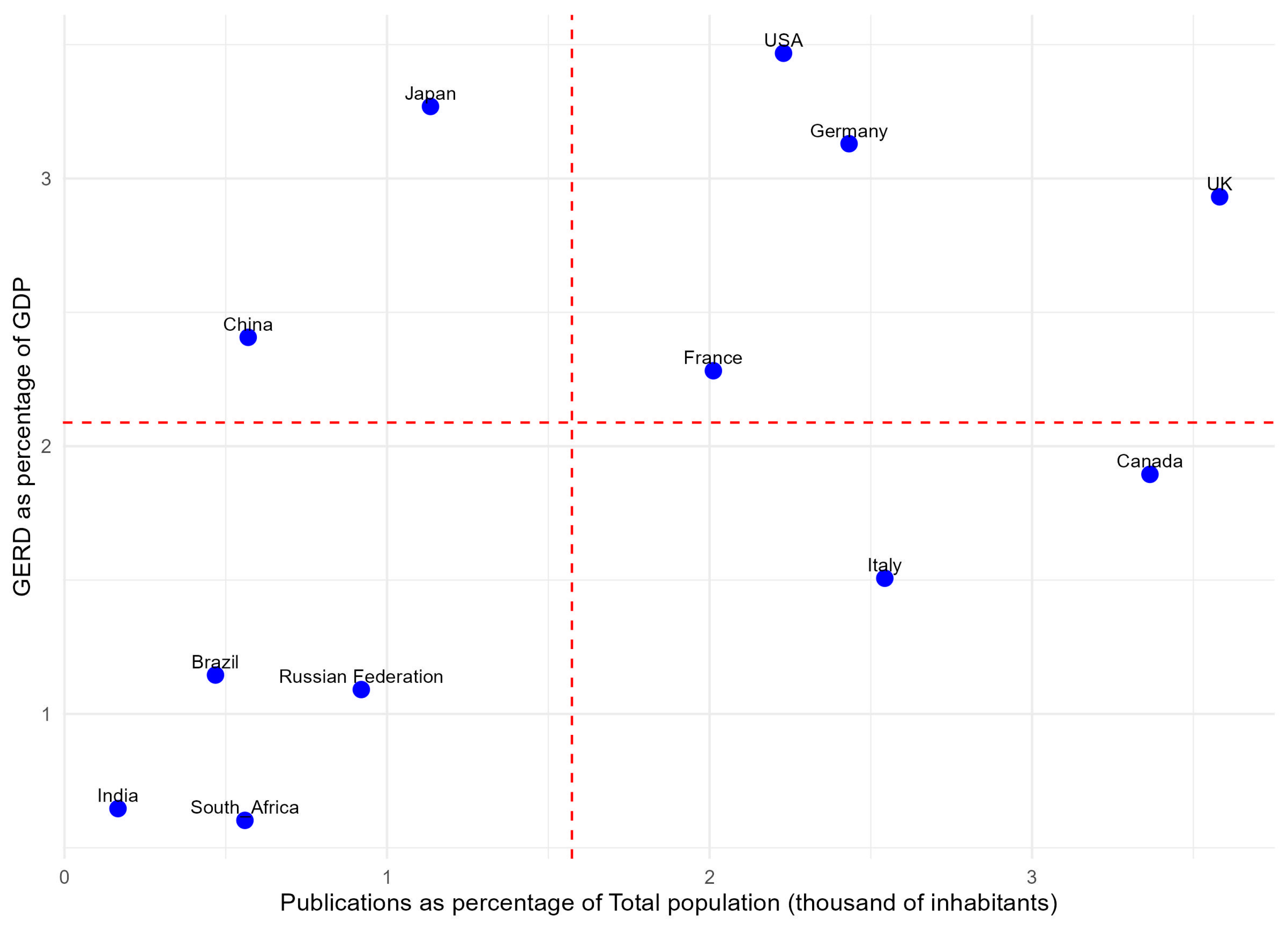
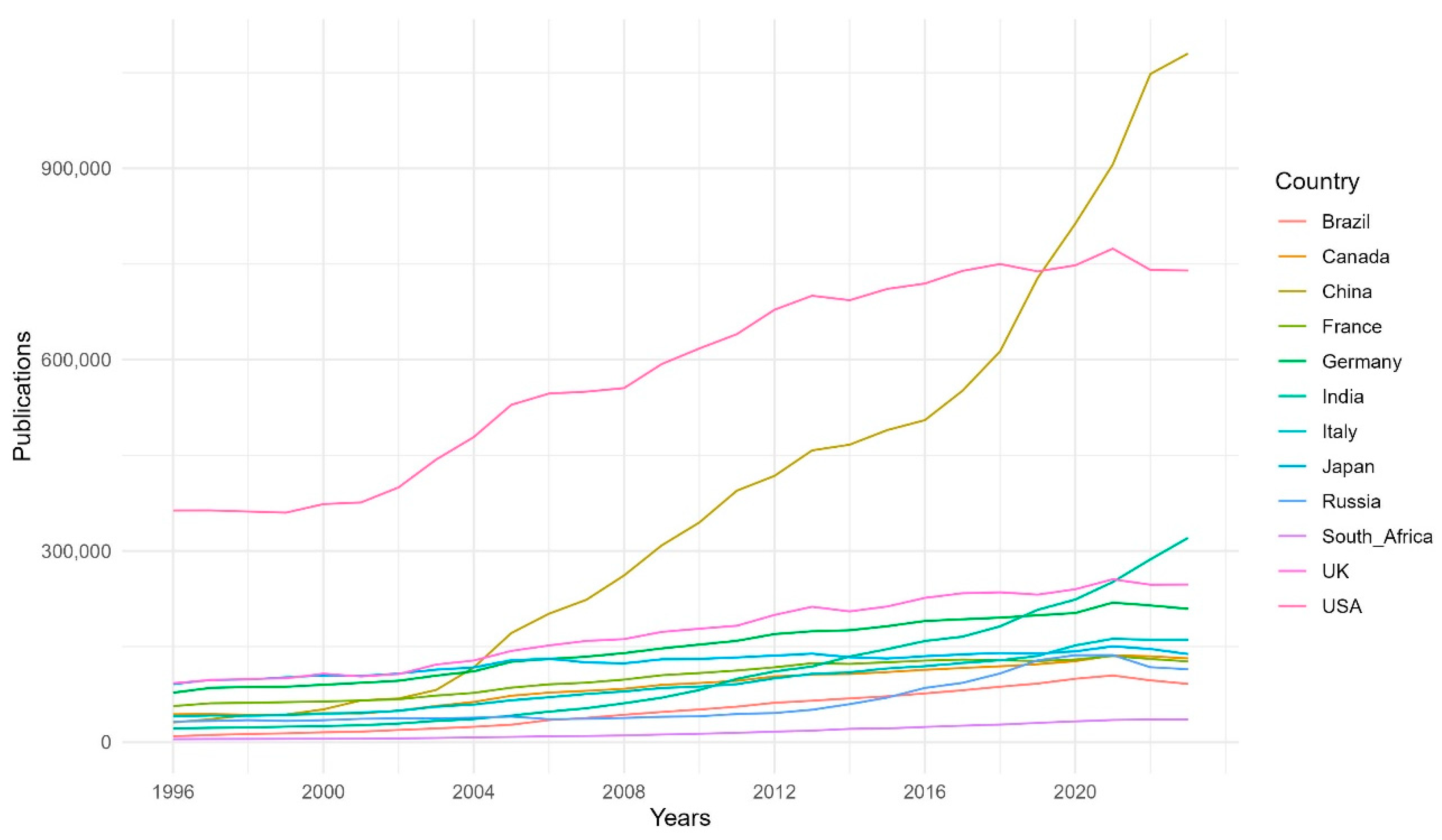
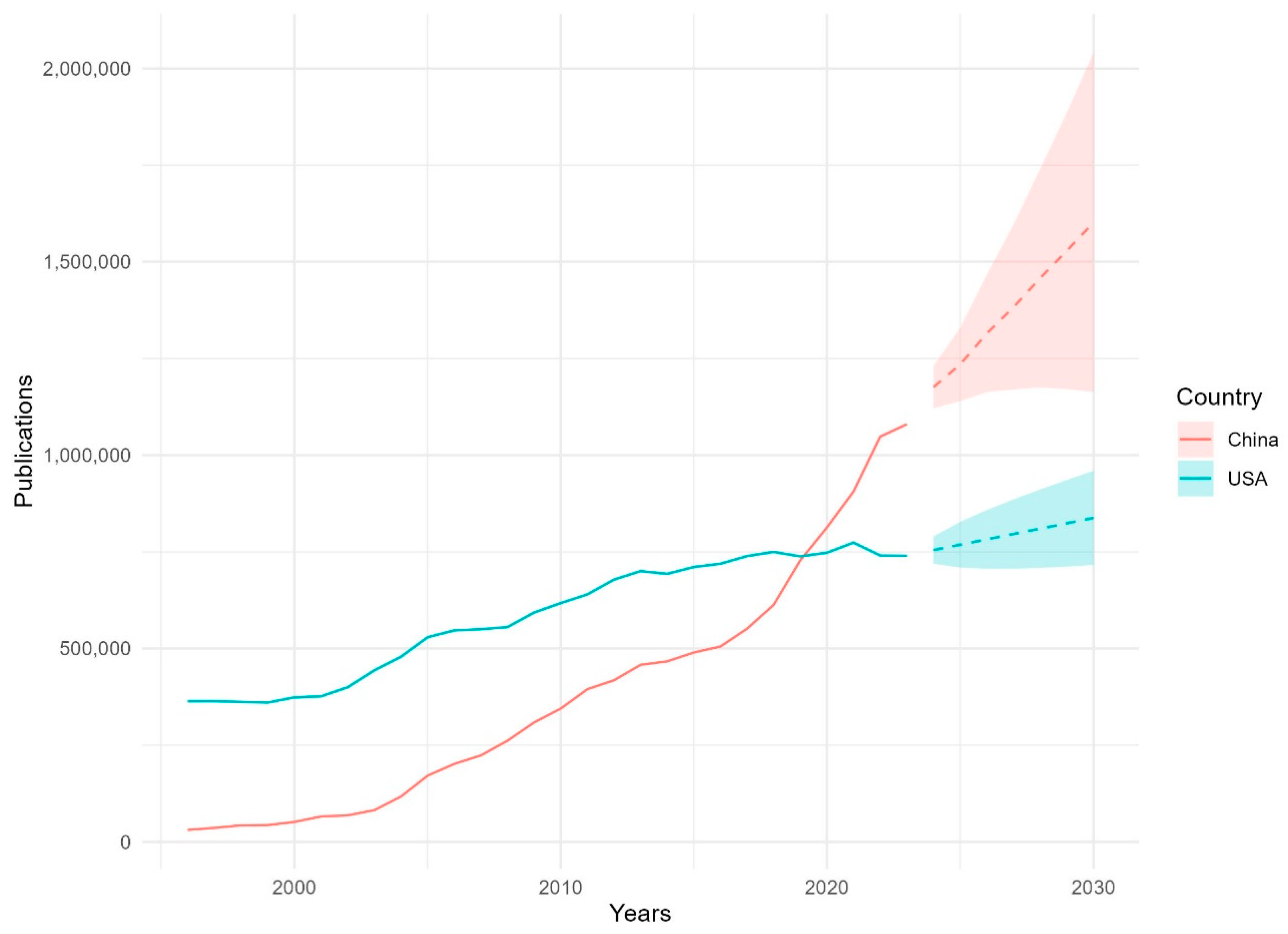
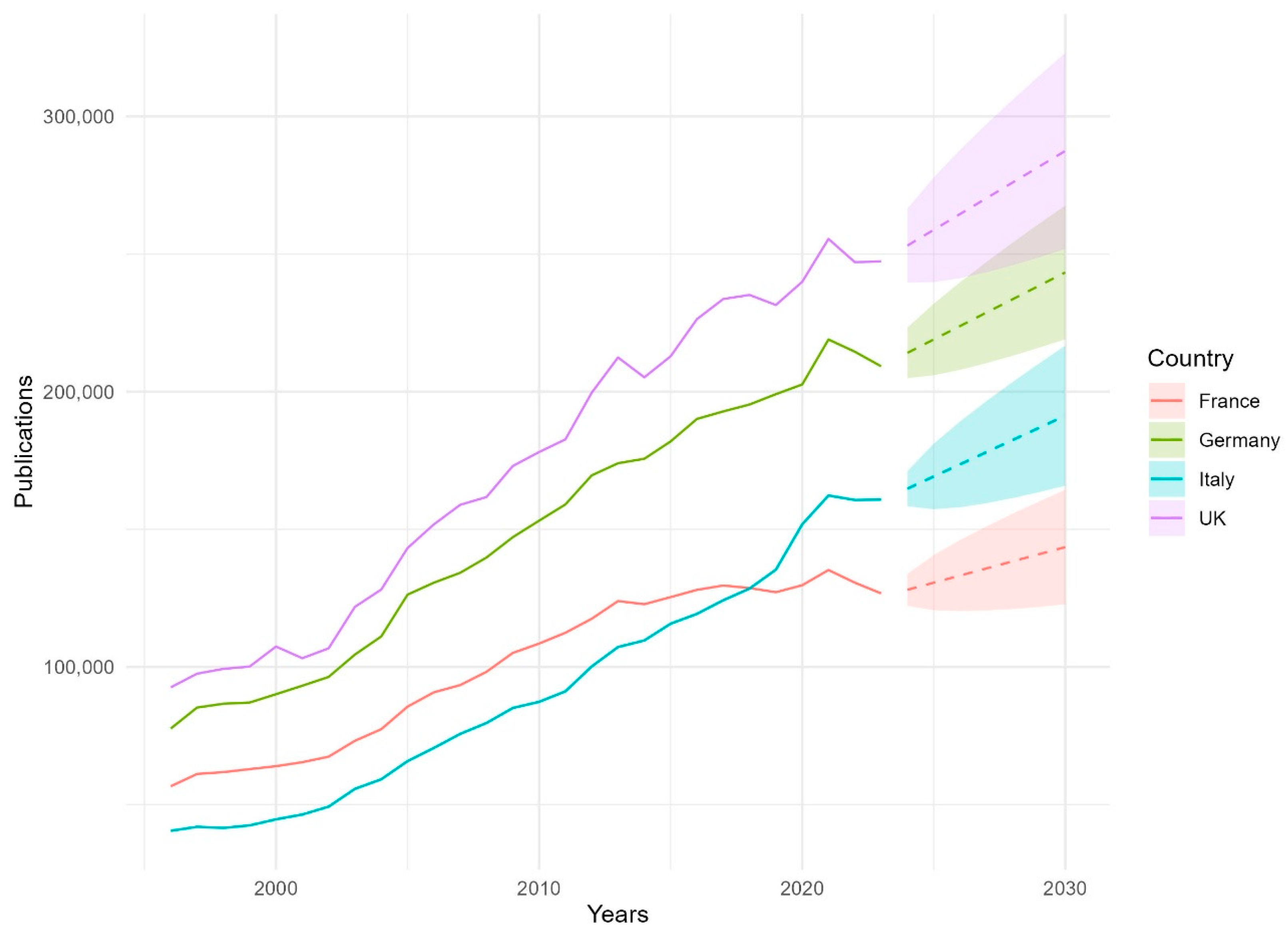
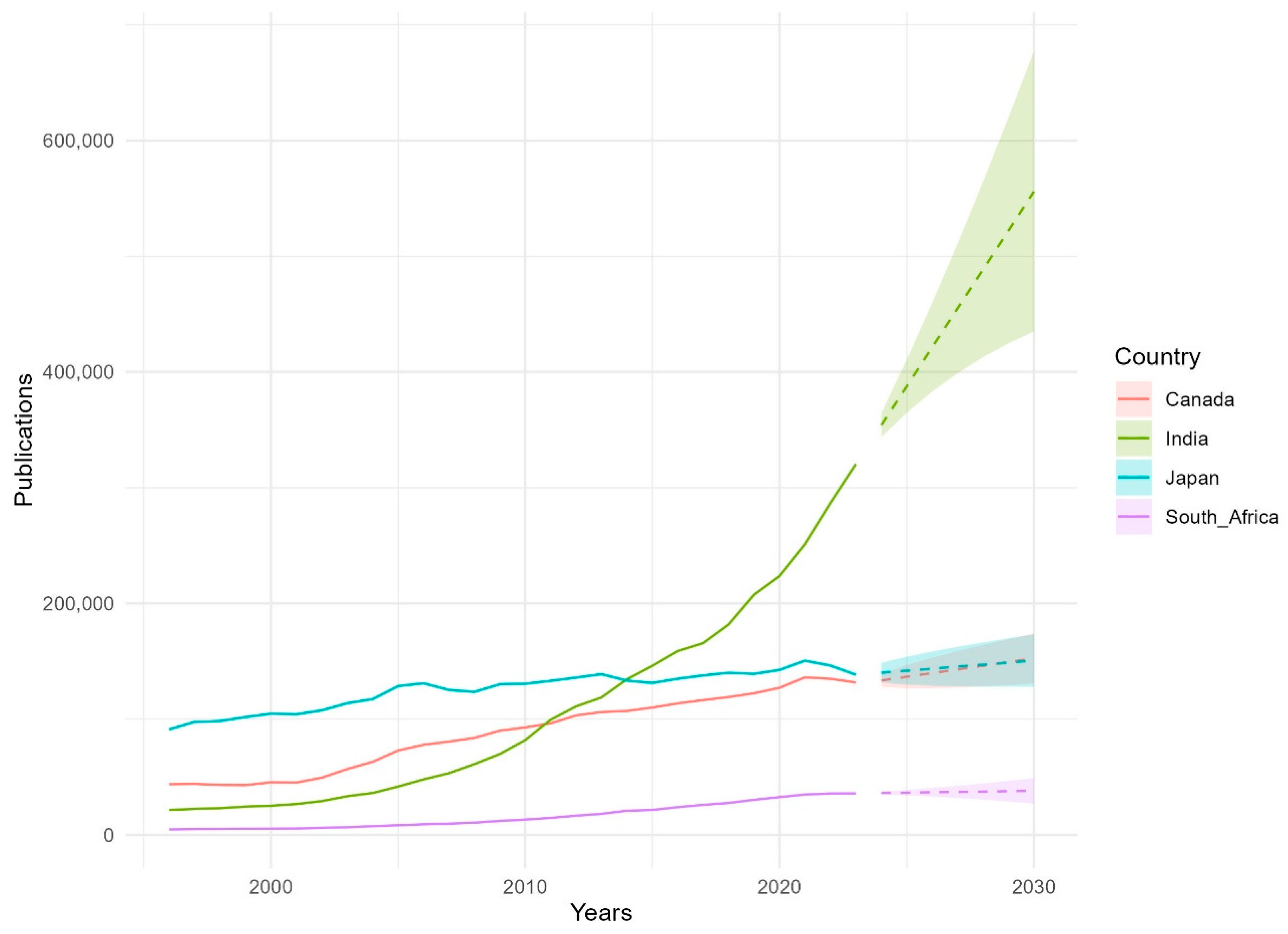
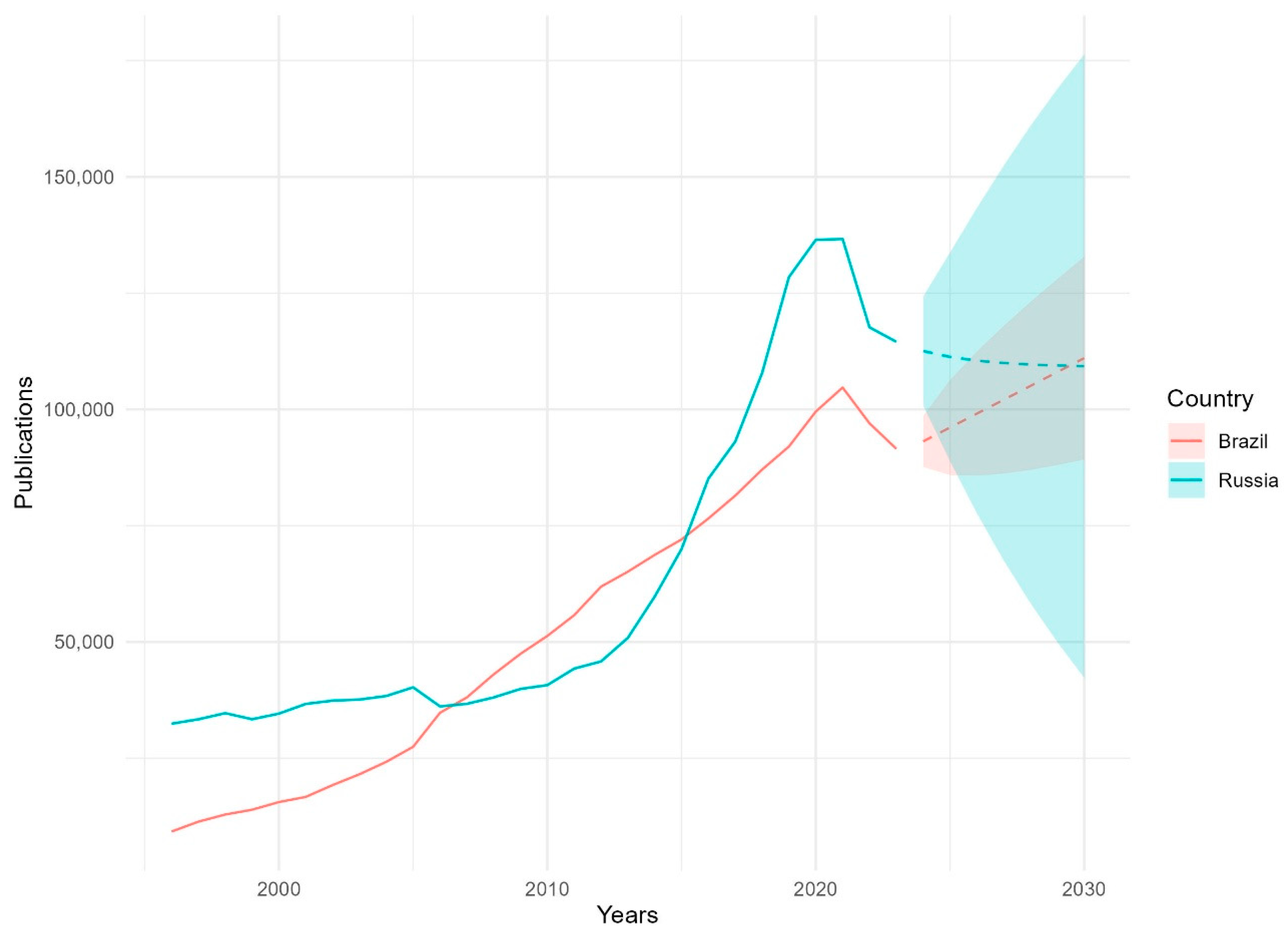
| Country | Model | Coefficients | ||
|---|---|---|---|---|
| ar(1) | ma(1) | drift | ||
| Canada | ARIMA(0,1,1) with drift | 0.541 | 3164.865 | |
| France | ARIMA(0,1,1) with drift | 0.410 | 2585.340 | |
| UK | ARIMA(0,1,0) with drift | 5731.630 | ||
| USA | ARIMA(0,1,1) with drift | 0.352 | 13,845.626 | |
| Italy | ARIMA(0,1,1) with drift | 0.572 | 4418.526 | |
| Japan | ARIMA(0,1,0) with drift | 1749.926 | ||
| Germany | ARIMA(0,1,0) with drift | 4873.704 | ||
| Brazil | ARIMA(0,1,1) with drift | 0.565 | 2983.144 | |
| China | ARIMA(1,2,0) | −0.581 | ||
| India | ARIMA(0,2,0) | |||
| Russia | ARIMA(1,1,0) | 0.637 | ||
| South Africa | ARIMA(1,2,0) | −0.481 | ||
| Country | AIC | BIC | MAE | RMSE | MAPE | Shapiro Test (p-Value) |
|---|---|---|---|---|---|---|
| Canada | 509.671 | 513.558 | 2001.415 | 2653.702 | 2.666 | 0.692 |
| France | 512.198 | 516.086 | 2095.486 | 2789.234 | 2.053 | 0.318 |
| UK | 556.625 | 559.217 | 5192.115 | 6612.271 | 3.045 | 0.519 |
| USA | 609.672 | 613.559 | 13,034.911 | 16,976.286 | 2.345 | 0.329 |
| Italy | 517.795 | 521.682 | 2360.566 | 3081.678 | 2.854 | 0.044 |
| Japan | 532.173 | 534.765 | 3207.351 | 4204.316 | 2.524 | 0.322 |
| Germany | 536.015 | 538.606 | 3233.852 | 4514.309 | 2.210 | 0.084 |
| Brazil | 509.647 | 513.534 | 1688.040 | 2650.645 | 3.854 | 0.000 |
| China | 609.283 | 611.800 | 17,260.026 | 26,269.517 | 6.045 | 0.014 |
| India | 520.923 | 522.181 | 3655.939 | 5030.627 | 3.254 | 0.349 |
| Russia | 549.644 | 552.236 | 3857.380 | 5754.703 | 5.364 | 0.004 |
| South Africa | 414.208 | 416.724 | 427.635 | 618.662 | 2.469 | 0.006 |
Disclaimer/Publisher’s Note: The statements, opinions and data contained in all publications are solely those of the individual author(s) and contributor(s) and not of MDPI and/or the editor(s). MDPI and/or the editor(s) disclaim responsibility for any injury to people or property resulting from any ideas, methods, instructions or products referred to in the content. |
© 2025 by the author. Licensee MDPI, Basel, Switzerland. This article is an open access article distributed under the terms and conditions of the Creative Commons Attribution (CC BY) license (https://creativecommons.org/licenses/by/4.0/).
Share and Cite
Cicero, T. Forecasting the Scientific Production Volumes of G7 and BRICS Countries in a Comparative Analysis. Publications 2025, 13, 6. https://doi.org/10.3390/publications13010006
Cicero T. Forecasting the Scientific Production Volumes of G7 and BRICS Countries in a Comparative Analysis. Publications. 2025; 13(1):6. https://doi.org/10.3390/publications13010006
Chicago/Turabian StyleCicero, Tindaro. 2025. "Forecasting the Scientific Production Volumes of G7 and BRICS Countries in a Comparative Analysis" Publications 13, no. 1: 6. https://doi.org/10.3390/publications13010006
APA StyleCicero, T. (2025). Forecasting the Scientific Production Volumes of G7 and BRICS Countries in a Comparative Analysis. Publications, 13(1), 6. https://doi.org/10.3390/publications13010006






